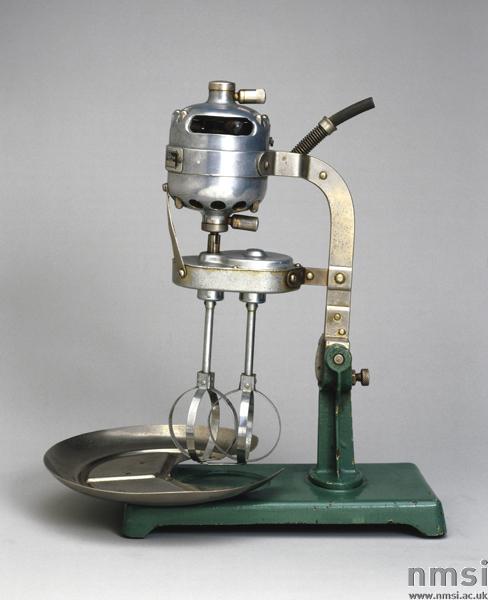The images I have chosen for this photographic essay range chronologically from the 1830’s to 1930’s. They are portrayed through a variety of mediums including photography, engraving, print and printed information leaflet. I chose these images because they represent an evolution in attitudes, practices and conventions around food in the city. Given the focus of the process of modernity on hygiene and sophistication, food must have been a natural area for development of modern ideals.
The first image (fig 1.1) in my photographic essay is of the kitchen in the Reform Club in London where many British Parliamentarians would have socialised (british-history.ac.uk). The image shows sinks, pantries and functional cooking ware which would have served as an idyllic cooking environment for the bourgeuosie of the time to aspire too. Alexis Soyer, who is argued to have been the world’s first celebrity chef, was a resident chef at the Reform Club.
![Fig 1.1 Description: Engraving: Kitchen, Reform Club. W. Radcliffe after G.B. Moore, c1830 [men, women preparing food] overall: 20.5x27cm http://collectionsonline.nmsi.ac.uk/grabimg.php?wm=1&kv=122852](https://bloggroupzero.wordpress.com/wp-content/uploads/2012/12/a-proj.jpg?w=584&h=526)
Fig 1.1 Description: Engraving: Kitchen, Reform Club. W. Radcliffe after G.B. Moore, c1830 [men, women preparing food] overall: 20.5x27cm http://collectionsonline.nmsi.ac.uk/grabimg.php?wm=1&kv=122852
The next image (fig 1.2) is from the same period and portrays a sort of artistic personification of beautifully engineered cooking utensils of the time. Images like this would have defused an admiration for the beauty and modernity of these instruments.

Fig 1.2 Description: Print: Implements animated in the kitchen c1830. Lithograph, trimmed to image edge, 30.5x23cm. Personification or composite style scene, a group, set in a kitchen wherein merrymaking is enjoyed by figures fashioned from domestic implements, food and appliances: notably a dancing bellows and tongs, mangle and pan musicians on washboards, plate balancing on clothes line trapeze, dog duck and other figures dancing or watching; irons on mantelpiece http://collectionsonline.nmsi.ac.uk/grabimg.php?wm=1&kv=126557
The inclusion of Fig 1.3, an advertisemnt for Colman’s mustard, was included to illustrate the growing availability of global food stuffs at the time. What is particularly interesting is that the Colman Family, who are now synonymous with Norwich, pioneered the very modern concept of social security in there city (collectionsonline.nmsi.ac.uk)

Fig 1.3 Description: Advert For Colman’s Mustard, Printer : Unknown, 1880, Colman family’s pioneering achievements in social welfare became part of Norwich’s history. In 1857 a school was opened for the employees’ children, while in 1864 the firm employed a nurse to help sick members of staff – a social revolution at the time. http://www.bl.uk/onlinegallery/onlineex/evancoll/a/014eva000000000u06919000.html
Fig 1.4 was included to show the growing influence of ethnically and culturally different food practices which would have become more common place in modern urban life at the turn of the century. Essentially urban centres were hubs for immigration and a diversity in food practices would have enriched, and in a sense, modernised urban food culture.

Fig 1.4 Description: Photograph of Jewish Butchers in Stepney from ‘The Alien Immigrant’ by Major W Evans Gordon, published 1903, Location: Jewish Museum London, Provider: Judaica Europeana http://www.jewishmuseum.org.uk/?unique_name=search-our-collections-new&adlibid=10173 (cropped version wont upload, sorry)

Fig 1.5 Description: Universal’ electric food mixer and beater, c. 1918., Creator: Landers, Frary & Clark (New Britain, Conn.), Data provider: Science Museum http://www.europeana.eu/portal/record/2022343/CC6E1FD961D94D6D18DD3C962C174CCA846A7141.html?query=food&qf=TYPE:IMAGE&qf=YEAR:1915
The Final image (Fig 1.5) is a photograph advertising an early food processor from 1918. It represents an intellectualisation of food production that began at the turn of the century and saw a growing movement of food production, and even cultivation, to supposedly sophisticated scientific practices. The processes of modernisation of food in the urban environment has drastically changed how people interact with and consume food.
References
http://www.british-history.ac.uk/report.aspx?compid=40611 [accessed on 3-12-2012]
http://collectionsonline.nmsi.ac.uk/grabimg.php?wm=1&kv=126557 [accessed on 2-12-2012]
